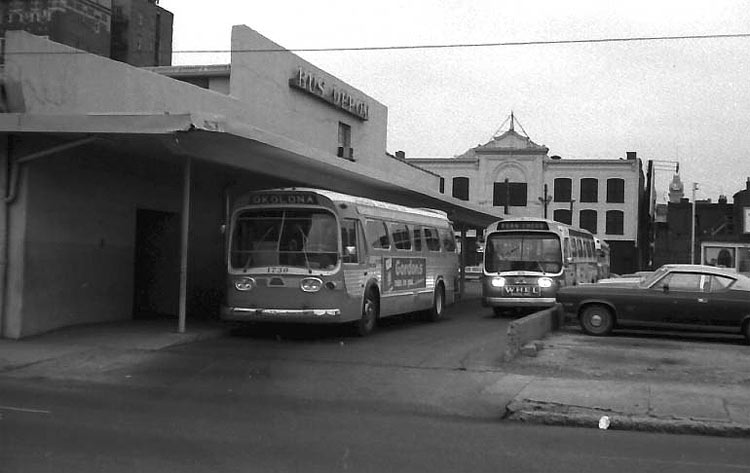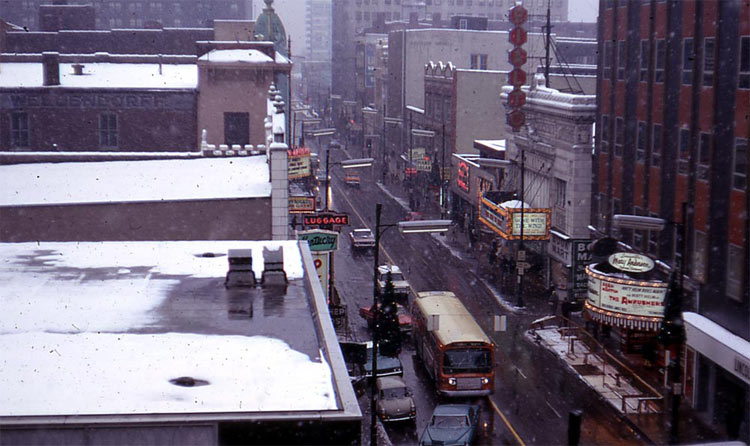The Transit Authority of River City posted a great collection of vintage buses to their Flickr page detailing the evolution of Louisville’s bus system over the past half century. From the fleur-de-lis patterned “Downtowner” circulator to the bright-red TARC Larc mini-bus, there have been some great retro designs over the years.
Equally interesting are the backdrops to the photos showing scenes of Louisville that have substantially changed or completely vanished. Above, for instance, the Palace is visible along with the Wright-Taylor building and WFPL headquarters, but the grand Rialto Theater, the Berkeley Apartments, and the Commonwealth Tower have long been destroyed. On the right hand side, the Chestnut Centre still exists in its modern beige color scheme, but its Mary Anderson Theater is no more. This photo was taken from the top of the parking garage at Fourth and Chestnut streets circa 1964.

Above, the old Union Bus Depot sits on the block now occupied by a Marriott hotel, spanning the block between Jefferson and Liberty streets between Second and Third streets. While the building isn’t fancy, does this count as an early example of intermodal transportation facility in Louisville? According to TARC, the depot served the Blue Motor Coach Lines, Kentucky Bus Lines, and Trailways among others. In the background, you can see the now-destroyed Savoy Theater that by this point had fallen from its heyday.

Here is a Blue Motor Coach bus serving suburban Louisville in the parking lot of the Union Bus Depot. According to TARC: “Their five routes ran ‘express’ within Louisville city limits (no local passengers) and stopped on signal at any other location outside of city limits. Blue Motor operated in and out of the Union Bus Depot on Liberty Street at 2nd Street. Their routes served Jeffersontown, Fern Creek, Camp Taylor, Poplar Level Road and St. Regis Park.”

Interestingly, the sprawling city of the 20th century was a boon to the Blue Motor Coach Lines as ridership in the suburbs spiked along their routes in the 1960s and 1970s. This model of bus made by GM featured a more modern look and blue line purchased ten of them beginning in 1964. All of the buildings in the background have been destroyed.

This is certainly one of the strangest buses that must have wandered the streets of Louisville. Here’s some background from TARC: “Flxette #2 was one of 18 minibuses purchased by TARC and actually were the first new buses introduced by the new transit system. These buses were used to introduce the 4th Street and Medical Center circulator routes as well as the Bashford Manor-Oxmoor Circulator. Not very well liked by bus operators, these things did not hold up very well in heavy-duty transit service.” In the background, you can see the Kentucky Tower and a now-gone Ollie’s Trolley food stand.


The Downtowner was the predecessor to those trolley-bus circulators we have now. The service operated on a loop on Fourth Street between Market Street and Broadway with a bus arriving every ten minutes. The service cost ten cents per ride.


A yellow-and-green bus travels east on Chestnut Street with the Caperton Block, still planned for redevelopment, in the background. The Caperton Annex behind it on Chestnut was later destroyed in a fire. From TARC: “Bus 765 is one of 50 buses purchased new by Louisville Railway Company in 1948 primarily to replace older, pre-war buses. These were model TDH4507 (Transit Diesel Hydraulic 45 passenger model 7). The buses were 35 feet long and 96 inches wide, a standard at that time. These buses continued to operate in daily service up until 1974 when TARC purchased its first new buses.”

From TARC: “Bridge Transit Company was the six-bus outfit that operated transit service between downtown Louisville and both Jeffersonville and Clarksville. From their garage on Court Street in Jeffersonville, they also operated a thriving small truck rental business. This is the Jeffersonville bus, shown here heading north on 4th Street at their stop between Guthrie Street and Walnut Street.”

From Tarc: “Bus 810 was part of the first group of new buses purchased in 1961 by Louisville Transit Company in over eight years. The new design from General Motors Truck & Coach featured 53 seats and optional air conditioning, which Louisville Transit deemed to be justified in the local summer climate. These buses also introduced a different (not new) orange and beige color scheme unfamiliar in Louisville, but identical to buses owned by the same company in Milwaukee and Indianapolis.”
Be sure to check out the rest of the buses on the TARC Flickr page.



The Commonwealth Building? Great, yet another large downtown building that I never knew existed…
Yes, it was the tallest building in the state for a while at 21 stories/255 feet tall. It was imploded in 1994. I am planning another story on it soon, so stay tuned. Here’s a photo:
http://farm3.static.flickr.com/2790/4491031355_923d1433d7_o.jpg
My partner works for AEGON which was once Capitol Holding, and he says the Commonwealth Tower was demolished when their new headquarters (now the AEGON Center) opened on Fourth and Market. But why in the world did they feel it was necessary to implode that gorgeous building?! I would have expected that to happen in the 70’s, not 1994. I’m glad other beautiful, tall buildings on that end of downtown didn’t suffer the same fate.
I’m flattered that my photos actually made it outside of TARC. I took them all, and many were taken when I was a teenager in the late sixties. The earlier views hearken from a time when downtown Louisville was a destination (rather than a distraction) in the region. As pointed out above, many of the historic buildings have been razed, most notably the great theatres on 4th Street south of Chestnut Street. We have new buildings – many ugly, soul-less Al Schneider abominations – in place of the old stuff, but the old buildings lent character to 4th Street and other thoroughfares. I have to admit that some of the old buildings on Liberty Street and Jefferson Street were seedy by the sixties, and the current convention center and Hyatt are a welcome replacement for likes of the Liberty News Store or the Savoy Theatre!
Great piece — but just one quibble:
The fourth photo — the one with the Liberty News Store in the background — is mislabeled.
That location of the Liberty newsstand was on the north side of Liberty between 3rd and 4th — not at 6th, as the caption states.
I bought enough comic books at that joint to know for sure. It later moved around the corner to a spot on the east side of 4th just a couple doors south of Liberty.
Its owner — a guy named Louie Loeser — was a true character. He was murdered at his home back in the seventies if I remember correctly. Not sure how that case ever turned out.
Ahhh, the Savoy – & the Milner Hotel! As a Blue Motor Coach rider in the early ’60s, those seedy, sketchy establishments lent an especially “grownup” adventurous aura & wonder to my Downtown excursions with my contemporaries.
But God bless Al Schneider for daring to take a chance on what was a dying commercial district. Kitsch can be good…
Wow, great photo of Fourth Street with the historic Rialto. It closed in July 1968 and was demolished in 1969. Loved going to movies there.
@Ray Foushee –
I didn’t see a reference to the location of Liberty News. It was, however, right next door to Louisville Transit Company’s office in the old interurban terminal between 4th and 3rd on Liberty.
If I recall correctly, the demolition of the Commonwealth Tower was a big production that included appearances by movie stars who were in Louisville promoting a big-budget Hollywood film. Am I wrong?
Jon, I believe you’re thinking of the implosion of the Belknap warehouses on the waterfront, also in the 90s and another regrettable event as the footage wasn’t even included in the movie as far as I know. More info here: http://brokensidewalk.com/2010/10/04/lost-louisville-belknap-warehouses/
Ray, Thanks for the clarification, I updated the caption.
Cliff, Great photos! Would love to see more. It’s a shame the city let so many old buildings be run down in the past, but I imagine we would be a lot better off today if we still had them. The seedy businesses shouldn’t be tied to the buildings themselves, which can be fixed up and given new uses. Imagine if the Savoy were some kind of music venue today.
This was a great article and loved the photography also, thanks all
Great to see these photos. My dad drove for Blue Motor Coach and is the probably driver in the Poplar Level Road bus #59. Thanks for the memories.
Cool. Loved those orange “New Look” GMs. The GMC RTS buses we had in the ’80s were fantastic with their flush glass and fuselage styling. Something most people take for granted but truly a high point in mass transit design.
I grew up in St. Matthews and rode the bus downtown or to Barret Middle School somewhat regularly. A great auditory and even olfactory sensation was two buses waiting at the stop or light at Shelbyville and Chenoweth Ln. The hot breeze radiating from the engine stirring up papers and debris. The smell of inefficiently burned fuel from a severely used machine with a tinge of pavement and the nearby White Castle. And the awesome, whirring growl and seemingly unlabored revs of the two stroke Detroit diesels.
Amen to the comic books at Liberty News, Ray! Got my MARVEL fix every month there, along with many other kids…it was a shady, seedy yet fascinating place.
Shady…seedy…
What more could a thirteen year old kid ask for?
My grandmother was Louisville’s first woman bus driver (and trolley before that) for Louisville Transit. She drove for 17 years.